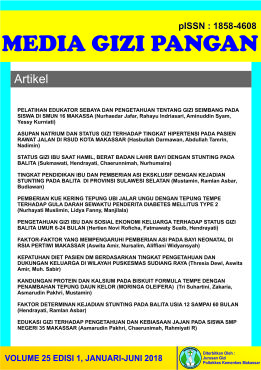HUBUNGAN RIWAYAT BBLR DENGAN STUNTING PADA ANAK BALITA DI KELURAHAN BORIBELLAYA KECAMATAN TURIKALE
DOI:
https://doi.org/10.32382/mgp.v30i2.279Kata Kunci:
Low Birth Weight, Stunting, ToddlerAbstrak
Toddler stunting is grouped as chronic nutritional problem which impact of many factors.The factor of children it self which can cause of stunting are low birth weight ( BBLR), the absence of breast feeding early, not exclusive of having breast milk, less quality and quantity of food companion to breast milk as well as infection disease. Based on health basic data research of the Minister of Health in 2010, 2013, and 2018 noted that national stunting cases were in a row at 35.6%, 37.2%, and 30.8%. In South Sulawesi found the cases were in a row 36.8%, 40.9%, and 35.6% While in Maros Regency stunting has prevalence rate at 34.87% in a short and shortest cases. Boribellaya area has the highest stunting prevalence in Turikale District is 13.8%. The purpose of this research was to know the relationships between Low Birth Weight and Stunting Cases in Boribellaya village. The techniques of research were observation and design cross sectional study. The research was conducted in June, 2021 at Boribelaya Village. The variables of the research were Low Birth Weight as independent variable and Stunting cases was dependent variable. Technique of data collection was interview of their identity and toddlers’ age. The stunting data collection was taken through secondary data from EPPGM 2021 by 52 children while for their birth weight was gotten from Book of Helth mother and child. The bias of this research found that not all or 28.8% (15 children) has not their birth weight notes in the Book of Mother and child. The long/height of the toddler were measured by using ribbon meter and not length board and microtoice.The population of this research was allof 52 toddlers which have stunting cases. Technique of sampling applied total sampling, while data analysis applied Bivariat Exact Fisher Test. The research result showed that the population age rate in 3-5 year was 59.6%, the gender was dominated by males in 59.6%. The higher with Low Birth Weight and without Low Birth Weight was 96.2%, Stunting was 73%, the child with severe stunting 27%, Low Birth Weight with stunting was 3.8%, The child With Low Birth Weight and stunting was 96.2% with the rate score was p=0.47 (>0.05). Based on above finding, it can be concluded that there is no correlation between Low Birth Weight and Stunting Cases at Toddler in Boribellava Village, Turikale District, Maros regency.
Referensi
Adelasanti, A. N. And Rakhma, L. R. (2018) ‘Hubungan Antara Kepatuhan Konsumsi Pemberian Makanan Tambahan Balita Dengan Perubahan Status Gizi Balita Di Puskesmas Pucangsawit Surakarta’, Jurnal Dunia Gizi, 1(2), Pp. 92–100. Doi: 10.33085/Jdg.V1i2.3073.
Black, R. E. Et Al. (2013) ‘Maternal And Child Undernutrition And Overweight In Low-Income And Middle-Income Countries’, The Lancet, 382(13), Pp. 427–451. Doi: 10.1016/S0140- 6736(13)60937-X.
Fitri, L. (2018) ‘Hubungan Bblr Dan Asi Ekslusif Dengan Kejadian Stunting Di Puskesmas Lima Puluh Pekanbaru’, Jurnal Endurance, 3(1), P. 131. Doi: 10.22216/Jen.V3i1.1767.
Galgamuwa, L. S. Et Al. (2017) ‘Nutritional Status And Correlated Socio-Economic Factors Among Preschool And School Children In Plantation Communities, Sri Lanka’, BMC Public Health, 17(1), Pp. 1–11. Doi: 10.1186/S12889-017-4311-Y.
Kemenkes RI (2018) Situasi Balita Pendek (Stunting) Di Indoneisa. Jakarta. Kesehatan, B. P. Dan P. (2018a) Laporan Provinsi Sulawesi Selatan. Jakarta. Kesehatan, B. P. Dan P. (2018b) Riset Kesehatan Dasar 2018. Jakarta.
Komalasari Et Al. (2020) ‘Faktor-Faktor Penyebab Kejadian Stunting Pada Balita’, Majalah Kesehatan Indonesia, 1(2), Pp. 51–56.
Kumala Putri, D. S. And Utami, N. H. (2015) ‘Nilai Batas Berat Lahir Sebagai Prediktor Kejadian Stunting Pada Anak Umur 6-23 Bulan Di Indonesia’, Penelitian Gizi Dan Makanan (The Journal Of Nutrition And Food Research), 38(1), Pp. 79–85. Doi: 10.22435/Pgm.V38i1.4425.79-85.
Lubis, F. S. M., Cilmiaty, R. And Magna, A. (2018) ‘Hubungan Beberapa Faktor Dengan Stunting Pada Balita Berat Badan Lahir Rendah’, Jurnal Kesehatan Kusuma Husada, Pp. 13–18. Doi: 10.34035/Jk.V9i1.254.
Majestika, S. (2018) Status Gizi Anak Dan Faktor Yang Mempengaruhi. Yogyakarta: UNY Press. Mukhlis, H. And Marini, M. (2020) ‘Pengaruh Terapi Murottal Terhadap Denyut Nadi Dan Pernafasan
Pada Bayi Dengan Berat Badan Lahir Rendah’, Indonesia Berdaya, 1(1), Pp. 29–37. Doi: 10.47679/Ib.202015.
Nainggolan, B. G. And Sitompul, M. (2019) ‘Hubungan Berat Badan Lahir Rendah (Bblr) Dengan Kejadian Stunting Pada Anak Usia 1-3 Tahun’, Nutrix Journal, 3(1), P. 36. Doi: 10.37771/Nj.Vol3.Iss1.390.
Nasution, D., Nurdiati, D. S. And Huriyati, E. (2014) ‘Berat Badan Lahir Rendah (BBLR) Dengan Kejadian Stunting Pada Anak Usia 6-24 Bulan’, Jurnal Gizi Klinik Indonesia, 11(1), P. 31. Doi: 10.22146/Ijcn.18881.
Riskesdas (2013) Riset Kesehatan Dasar (RISKESDAS) 2013, Laporan Nasional 2013. Jakarta. Doi: 1 Desember 2013.
Ruaida, N. And Soumokil, O. (2018) ‘Hubungan Status Kek Ibu Hamil Dan Bblr Dengan Kejadian Stunting Pada Balita Di Puskesmas Tawiri Kota Ambon’, Jurnal Kesehatan Terpadu (Integrated Health Journal), 9(2), Pp. 1–7. Doi: 10.32695/Jkt.V2i9.12.
Sari, E. M. And Soimah, N. (2017) Hubungan Riwayat BBLR Dengan Kejadian Stunting Pada Anak Usia 7-12 Bulan Di Desa Selomartani Wilayah Kerja Puskesmas Kalasan, Universitas ’Aisyiyah Yogyakarta. Universitas As’Aisyiysh.
Sukmawati Et Al. (2018) ‘Status Gizi Ibu Saat Hamil, Berat Badan Lahir Bayi Dengan Stunting Pada Balita’, Media Gizi Pangan, 25(1), Pp. 18–25.
Sundari, R. M. (2018) Hubungan Berat Badan Lahir Rendah (Bblr) Dan Perilaku Pemberian Asi Eksklusif Dengan Kejadian Stunting Baduta Di Puskesmas Sangkrah Kota Surakarta. Universitas Muhammadiyah Surakarta.
Supriyanto, Y., Paramasahanti, B. A. And Astiti, D. (2014) ‘Berat Badan Lahir Rendah (BBLR) Dengan Kejadian Stunting Pada Anak Usia 6-24 Bulan’, Jurnal Gizi Klinik Indonesia, 11(1), P. 31. Doi: 10.22146/Ijcn.18881.
Turikale, P. (2021) Hasil Operasi Timbang Kecamatan Turikale 2021. Maros.
Winowatan, G. Et Al. (2017) Hubungan Antara Berat Badan Lahir Anak Dengan Kejadian Stunting Pada Anak Batita Di Wilayah Kerja Puskesmas Sonder Kabupaten Minahasa, Kesmas. Universitas Sam Ratulan
Unduhan
Diterbitkan
Terbitan
Bagian
Lisensi
Hak Cipta (c) 2023 Lydia Fanny, Sukmawati Sukmawti, Hikmawati Mas’ud, Sirajuddin

Artikel ini berlisensi Creative Commons Attribution-NonCommercial-NoDerivatives 4.0 International License.
PDF downloaded: 694










